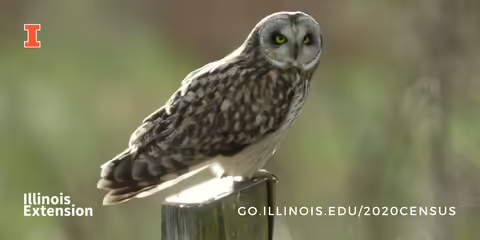URBANA, Ill. – Constitutionally required, the census attempts to record every US resident every 10 years. Federal funding is based on census population, including funding for wildlife, ecosystems, and air and water quality.
"Many federally funded programs that keep our drinking water safe, our wildlife healthy, and support us in times of natural disasters heavily depend on this once-a-decade count," says Abigail Garofalo, University of Illinois Extension energy and environmental stewardship educator. "Completing the census supports clean air, water, and supported wildlife in Illinois."
State Clean Diesel Grant Program
Diesel emissions add soot and fine particles in the air. The State Clean Diesel Grant Program provides state funding to reduce diesel emissions. For example, Ozinga Ready Mix Concrete was awarded $974,551 for 19 compressed natural gas concrete mixer trucks. Illinois' share of this grant program was based on 2010 census data.
State Wildlife Grants
The State Wildlife Grant Program helps state fish and wildlife agencies improve wildlife habitats covered by the Species of Greatest Conservation Need. The Illinois Department of Natural Resources' Illinois’ Wildlife Action Plan endorses research, surveys, restoration, and habitat management to protect the most vulnerable species. For two years, Illinois addressed conservation issues and management of herpetofauna (reptiles and amphibians).
"The funding each state receives for wildlife grants depends on the number of people in each state," Garofalo says. "Safe drinking water, wildlife health, and natural disaster relief rely on accurate population counts."
The following efforts receive federal funding based on census data: wildlife restoration and preservation; water pollution control; water and waste disposal; emergency watershed protection; hunter education and safety; emergency community and water assistance; beach monitoring and notification program implementation; underground water source protection; community fire assistance; and energy programs.
Extension outlines additional family and community assistance programs impacted by census data at go.illinois.edu/2020census. The deadline for completing the census, either by mail, phone, or online, ends September 30.
SOURCE: Abigail Garofalo, Extension Educator, Energy and Environmental Stewardship, Illinois Extension
WRITER: Judy Mae Bingman, Communications and Marketing Manager, Illinois Extension
ABOUT EXTENSION: Illinois Extension leads public outreach for University of Illinois by translating research into action plans that allow Illinois families, businesses, and community leaders to solve problems, make informed decisions, and adapt to changes and opportunities.
